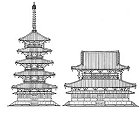Asuka Period |
|
|
The Asuka period spanned the years between approximately 552 AD and 710 AD. Up until that time, Japanís religion was based on the Shinto religion, an ancient animistic religion that is still practiced today. However, the Asuka period marked the emergence of Buddhism and as a result, fundamental changes occurred in not only religious beliefs, but also the architecture of Japan. A new type of architecture developed that differed greatly from the typical Shinto shrine: the Buddhist temple. The temple architecture of the Asuka period relied heavily on the influence of Chinese architecture. Compared to the simple design and construction of Shinto shrines, the temples that were being developed in the Chinese style were very sophisticated in their construction techniques and decoration. The Japanese greatly admired Chinese culture, which became very influential. In Japan, the planning and construction techniques of China's Tíang dynasty were studied and applied to Japanese architecture. On the other hand, the architecture did not completely imitate the architecture of China. Many variables dictated a significant difference in aesthetics and style. The environment in China differed greatly from that of Japan. Where Japan had mostly lush, and intimate green forests nestled among small mountain ranges, China had much more harsh and savage mountainous terrain that went from both extremes of hot and cold but not much in between. As a result, the Japanese were more likely to build with a close connection with their environmental surroundings with natural materials and not as a protest against nature, where as the Chinese were more apt to design buildings in order to protect and separate themselves from nature by using heavy and solid stones to build walls. Although many fine examples of temples were built during the Asuka period, they were constructed of wood and many have burned down or been destroyed by war. The following example has survived and can be visited today.
|
